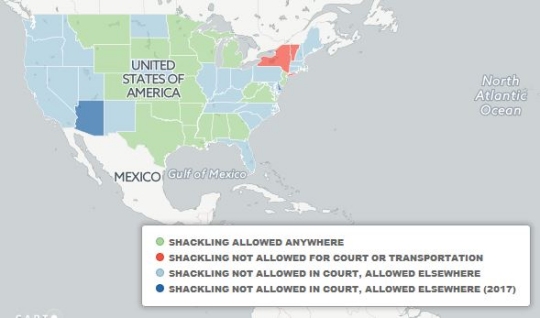 Advocacy groups for juvenile justice have been pushing for juvenile shackling policy changes in Maryland. A task force has been put together to analyze other states' policies. Maryland is one of 24 states that allows juvenile offenders to be shackled during transportation but not in court. In 2017, Delaware and Arizona will also adopt this policy. Two states have banned shackling during transportation and don't practice shackling in court, and 22 states have no policy, which means juvenile offenders can be shackled anywhere. (Chart by Teresa Lo)
Advocacy groups for juvenile justice have been pushing for juvenile shackling policy changes in Maryland. A task force has been put together to analyze other states' policies. Maryland is one of 24 states that allows juvenile offenders to be shackled during transportation but not in court. In 2017, Delaware and Arizona will also adopt this policy. Two states have banned shackling during transportation and don't practice shackling in court, and 22 states have no policy, which means juvenile offenders can be shackled anywhere. (Chart by Teresa Lo)ANNAPOLIS (Oct. 26, 2016)—Maryland legislators and juvenile justice advocates are reviewing the state's policy for placing children in mechanical restraints and studying other states' laws to form a best practice.
The U.S. Supreme Court has held that adults should not be shackled in court to maintain the presumption of innocence, yet 22 states allow children to be restrained in the courtroom.
The mechanical restraints used on children include leg irons and belly chains and can weigh up to 25 pounds, according to the National Juvenile Defender Center. Handcuffs alone are considered a form of shackling.
A resolution from the Maryland Judiciary was adopted in Maryland in September 2015 to prohibit the shackling of children in juvenile court, although the practice was continued until July, when the Maryland Court of Special Appeals issued an order requiring restraints to be removed from children, said Christina Gilbert, the lead of the Campaign Against Indiscriminate Shackling with the National Juvenile Defender Center.
"In the United States, we treat children in our court system worse than any other industrialized nation," she said. "Really what we should be doing is promoting well-being and positive outcomes and everything we know about shackling is contrary to those goals."
Some legislators in Maryland wanted to take the shackling ban a step further during the last session of the General Assembly to completely prohibit the use except in special circumstances. However, the bill was changed to instead establish a task force to further study the effects of shackling and strip searching juveniles.
The task force has conducted several meetings this year and is expected to submit a final report to Gov. Larry Hogan by the end of the year, and create a series of recommendations that would outline possible legislation.
The Maryland Department of Juvenile Services has also said it is open to making changes within the department that wouldn't require legislation, said Audra Harrison, a spokeswoman.
"The department always seeks to balance the needs of youth with the safety and security of our facilities, youth, staff and our communities," she wrote in an email. "The department will propose recommendations that can be safely implemented in our facilities that also protect the dignity of the youth in our care."
Shackling—or placing a person in restraints—is helpful to minimize violence and protect law enforcement officers, said Sue Esty, the legislative director for Maryland's American Federation of State and County Municipal Employees, a union for state workers.
Gang activity and violence pose a threat at many of Maryland's juvenile detention centers, she said.
"In Annapolis, there's a lot of issues where we can sit down in a room and work on issues together and it's not always partisan," said Sen. Justin Ready, R-Carroll, a member of the task force. "Sometimes it's trying to figure out the best public policy."
The task force is also comparing common practices in other states to those in Maryland.
In 2014, only 10 states had a limit on automatic shackling of children in court, said Gilbert. Now, 28 states—including Maryland—as well as Washington, D.C., have laws that prevent restraints in the courtroom.
However, only Vermont and New York have laws prohibiting shackling children during transportation, which subsequently means children are not shackled in courtrooms either.
Similar policies should be applied to other states, Gilbert told the University of Maryland's Capital News Service. The effects of shackling in the courtroom undoubtedly apply to other locations as well, she said.
"We know about the trauma and the mental health harm that shackling causes, and trauma doesn't stop at the courtroom door," she said.
While there has been limited research on the psychological impact of shackling a child, some evidence from individual cases could point to several negative effects, said Jennifer Woolard, an associate professor of psychology at Georgetown University.
"Adolescents are really attuned to thinking about fairness and so those kinds of things could lead us to wonder and to be concerned about what the impact of shackling might be," she said.
Woolard—who has been conducting research on juvenile justice issues for more than 20 years—testified at the task force's Oct. 7 meeting about the importance of considering the psychological differences between children and adults.
"We're focused on research about the medical and mental health harm and trauma, but also there's research that we have that shows that shackling impairs communication skills and cognitive ability," she said.
But removing shackles could pose a safety issue for both employees and other children in detention centers, said Ready, who said he is "firmly against" changing the shackling policies.
"Most of them are 15 to 18 years old and they've earned their spot to be there," he said. "You do need to be sure that you're protecting the community, you're protecting the workers that are there and you're protecting the other young people that are there."
Shackles do help to limit violence in detention centers, said Esty.
"Restraints are actually very important considering the potential of youth to harm themselves," she said during the public comment at the task force meeting earlier this month.
Still, Gilbert says the juvenile justice system is "designed to be rehabilitative rather than punishing," and the idea of shackling goes against that concept.
"I think it's definitely time that the rest of the country follows suit both in the courtroom and out of the courtroom," she said.


